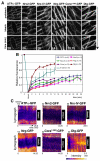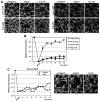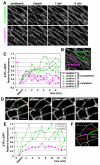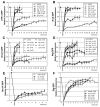Analysis of protein dynamics within the septate junction reveals a highly stable core protein complex that does not include the basolateral polarity protein Discs large
- PMID: 21807950
- PMCID: PMC3148133
- DOI: 10.1242/jcs.087700
Analysis of protein dynamics within the septate junction reveals a highly stable core protein complex that does not include the basolateral polarity protein Discs large
Abstract
Barrier junctions prevent pathogen invasion and restrict paracellular leakage across epithelial sheets. To understand how one barrier junction, the septate junction (SJ), is regulated in vivo, we used fluorescence recovery after photobleaching (FRAP) to examine SJ protein dynamics in Drosophila. Most SJ-associated proteins, including Coracle, Neurexin IV and Nervana 2, displayed similar, extremely immobile kinetics. Loss of any of these components resulted in dramatically increased mobility of all others, suggesting that they form a single, highly interdependent core complex. Immobilization of SJ core components coincided with formation of the morphological SJ but occurred after their known role in maintaining epithelial polarity, suggesting that these functions are independent. In striking contrast to the core components, the tumor suppressor protein Discs large was much more mobile and its loss did not affect mobility of core SJ proteins, suggesting that it is not a member of this complex, even though it colocalizes with the SJ. Similarly, disruption of endocytosis affected localization of SJ core components, but did not affect their mobility. These results indicate that formation of a stable SJ core complex is separable from its proper subcellular localization, and provide new insights into the complex processes that regulate epithelial polarity and assembly of the SJ.
© 2011. Published by The Company of Biologists Ltd
Figures









Similar articles
-
The lateral mobility of cell adhesion molecules is highly restricted at septate junctions in Drosophila.BMC Cell Biol. 2008 Jul 18;9:38. doi: 10.1186/1471-2121-9-38. BMC Cell Biol. 2008. PMID: 18638384 Free PMC article.
-
Neuroglian, Gliotactin, and the Na+/K+ ATPase are essential for septate junction function in Drosophila.J Cell Biol. 2003 Jun 9;161(5):979-89. doi: 10.1083/jcb.200212054. Epub 2003 Jun 2. J Cell Biol. 2003. PMID: 12782686 Free PMC article.
-
The ESCRT machinery regulates retromer-dependent transcytosis of septate junction components in Drosophila.Elife. 2020 Dec 30;9:e61866. doi: 10.7554/eLife.61866. Elife. 2020. PMID: 33377869 Free PMC article.
-
Molecular organization and function of invertebrate occluding junctions.Semin Cell Dev Biol. 2014 Dec;36:186-93. doi: 10.1016/j.semcdb.2014.09.009. Epub 2014 Sep 17. Semin Cell Dev Biol. 2014. PMID: 25239398 Review.
-
Composition and formation of intercellular junctions in epithelial cells.Science. 2002 Dec 6;298(5600):1955-9. doi: 10.1126/science.1072161. Science. 2002. PMID: 12471248 Review.
Cited by
-
Select Septate Junction Proteins Direct ROS-Mediated Paracrine Regulation of Drosophila Cardiac Function.Cell Rep. 2019 Aug 6;28(6):1455-1470.e4. doi: 10.1016/j.celrep.2019.07.004. Cell Rep. 2019. PMID: 31390561 Free PMC article.
-
Apical-basal polarity and the control of epithelial form and function.Nat Rev Mol Cell Biol. 2022 Aug;23(8):559-577. doi: 10.1038/s41580-022-00465-y. Epub 2022 Apr 19. Nat Rev Mol Cell Biol. 2022. PMID: 35440694 Review.
-
Endocytosis at the Crossroad of Polarity and Signaling Regulation: Learning from Drosophila melanogaster and Beyond.Int J Mol Sci. 2022 Apr 23;23(9):4684. doi: 10.3390/ijms23094684. Int J Mol Sci. 2022. PMID: 35563080 Free PMC article. Review.
-
Cell division and the maintenance of epithelial order.J Cell Biol. 2014 Oct 27;207(2):181-8. doi: 10.1083/jcb.201408044. J Cell Biol. 2014. PMID: 25349258 Free PMC article. Review.
-
RhoGAP68F controls transport of adhesion proteins in Rab4 endosomes to modulate epithelial morphogenesis of Drosophila leg discs.Dev Biol. 2015 Mar 15;399(2):283-95. doi: 10.1016/j.ydbio.2015.01.004. Epub 2015 Jan 21. Dev Biol. 2015. PMID: 25617722 Free PMC article.
References
-
- Baumgartner S., Littleton J. T., Broadie K., Bhat M. A., Harbecke R., Lengyel J. A., Chiquet-Ehrismann R., Prokop A., Bellen H. J. (1996). A Drosophila neurexin is required for septate junction and blood-nerve barrier formation and function. Cell 87, 1059-1068 - PubMed
-
- Behr M., Riedel D., Schuh R. (2003). The claudin-like megatrachea is essential in septate junctions for the epithelial barrier function in Drosophila. Dev. Cell 5, 611-620 - PubMed
-
- Bhat M. A., Rios J. C., Lu Y., Garcia-Fresco G. P., Ching W., St Martin M., Li J., Einheber S., Chesler M., Rosenbluth J., et al. (2001). Axon-glia interactions and the domain organization of myelinated axons requires neurexin IV/Caspr/Paranodin. Neuron 30, 369-383 - PubMed
-
- Bilder D., Perrimon N. (2000). Localization of apical epithelial determinants by the basolateral PDZ protein Scribble. Nature 403, 676-680 - PubMed
-
- Bilder D., Li M., Perrimon N. (2000). Cooperative regulation of cell polarity and growth by Drosophila tumor suppressors. Science 289, 113-116 - PubMed
Publication types
MeSH terms
Substances
Grants and funding
LinkOut - more resources
Full Text Sources
Other Literature Sources
Molecular Biology Databases
Miscellaneous

